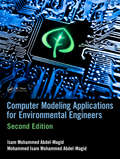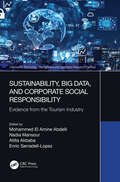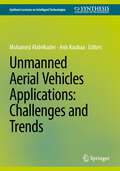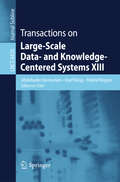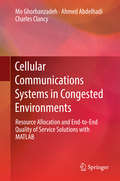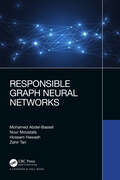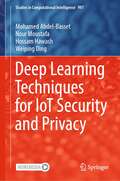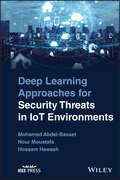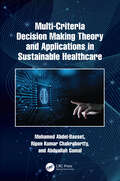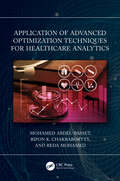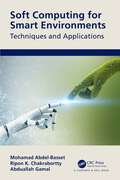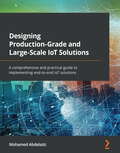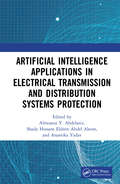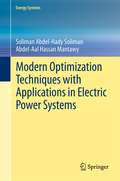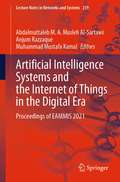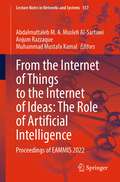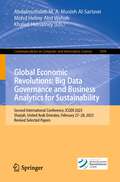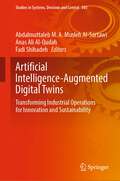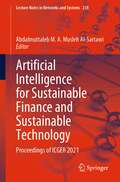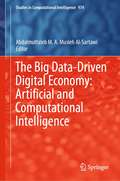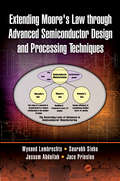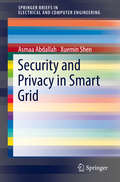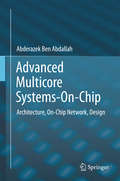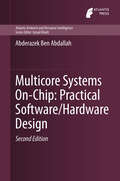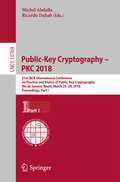- Table View
- List View
Computer Modeling Applications for Environmental Engineers
by Isam Mohammed Abdel-Magid Ahmed Mohammed Isam Mohammed Abdel-MagidComputer Modeling Applications for Environmental Engineers in its second edition incorporates changes and introduces new concepts using Visual Basic.NET, a programming language chosen for its ease of comprehensive usage. This book offers a complete understanding of the basic principles of environmental engineering and integrates new sections that address Noise Pollution and Abatement and municipal solid-waste problem solving, financing of waste facilities, and the engineering of treatment methods that address sanitary landfill, biochemical processes, and combustion and energy recovery. Its practical approach serves to aid in the teaching of environmental engineering unit operations and processes design and demonstrates effective problem-solving practices that facilitate self-teaching. A vital reference for students and professional sanitary and environmental engineers this work also serves as a stand-alone problem-solving text with well-defined, real-work examples and explanations.
Sustainability, Big Data, and Corporate Social Responsibility: Evidence from the Tourism Industry (Information Technology, Management and Operations Research Practices)
by Abdelli, Mohammed El AmineThis book aims to provide theoretical and empirical frameworks and highlights the challenges and solutions with using Big Data for Corporate Social Responsibility (CSR) and Sustainability in the field of digital transformation and tourism. Sustainability, Big Data, and Corporate Social Responsibility: Evidence from the Tourism Industry offers a theoretical and empirical framework in the field of digital transformation and applies it to the tourism sector. It discusses Big Data used with CSR and sustainability for the improvement of innovation and highlights the challenges and prospects. It presents a modern insight and approach for use by decision-makers as an application to solve various problems and explores how data collection can shed light on consumer behavior making it possible to account for existing situations and plan for the future. This book is intended to provide a modern insight for researcher, students, professionals, and decision-makers on the application of Big Data to improve CSR and sustainability in the tourism sector.
Unmanned Aerial Vehicles Applications: Challenges and Trends (Synthesis Lectures on Intelligent Technologies)
by Mohamed Abdelkader Anis KoubaaThis is a book that covers different aspects of UAV technology, including design and development, applications, security and communication, and legal and regulatory challenges. The book is divided into 13 chapters, grouped into four parts. The first part discusses the design and development of UAVs, including ROS customization, structured designs, and intelligent trajectory tracking. The second part explores diverse applications such as search and rescue, monitoring distributed parameter systems, and leveraging drone technology in accounting. The third part focuses on security and communication challenges, including security concerns, multi-UAV systems, and communications security. The final part delves into the legal and regulatory challenges of integrating UAVs into non-segregated airspace. The book serves as a valuable resource for researchers, practitioners, and students in the field of unmanned aerial vehicles, providing a comprehensive understanding of UAV technology and its applications.
Transactions on Large-Scale Data- and Knowledge-Centered Systems XIII (Lecture Notes in Computer Science #8420)
by Abdelkader Hameurlain, Josef Küng and Roland WagnerThis, the 13th issue of Transactions on Large-Scale Data and Knowledge-Centered Systems, contains six revised selected regular papers. Topics covered include federated data sources, information filtering, web data clouding, query reformulation, package skyline queries and SPARQL query processing over a LaV (Local-as-View) integration system.
Cellular Communications Systems in Congested Environments: Resource Allocation and End-to-End Quality of Service Solutions with MATLAB
by Ahmed Abdelhadi Mo Ghorbanzadeh Charles ClancyThis book presents a mathematical treatment of the radio resource allocation of modern cellular communications systems in contested environments. It focuses on fulfilling the quality of service requirements of the living applications on the user devices, which leverage the cellular system, and with attention to elevating the users' quality of experience. The authors also address the congestion of the spectrum by allowing sharing with the band incumbents while providing with a quality-of-service-minded resource allocation in the network. The content is of particular interest to telecommunications scheduler experts in industry, communications applications academia, and graduate students whose paramount research deals with resource allocation and quality of service.
Responsible Graph Neural Networks
by Mohamed Abdel-Basset Nour Moustafa Hossam Hawash Zahir TariMore frequent and complex cyber threats require robust, automated, and rapid responses from cyber-security specialists. This book offers a complete study in the area of graph learning in cyber, emphasizing graph neural networks (GNNs) and their cyber-security applications. Three parts examine the basics, methods and practices, and advanced topics. The first part presents a grounding in graph data structures and graph embedding and gives a taxonomic view of GNNs and cyber-security applications. The second part explains three different categories of graph learning, including deterministic, generative, and reinforcement learning and how they can be used for developing cyber defense models. The discussion of each category covers the applicability of simple and complex graphs, scalability, representative algorithms, and technical details. Undergraduate students, graduate students, researchers, cyber analysts, and AI engineers looking to understand practical deep learning methods will find this book an invaluable resource.
Deep Learning Techniques for IoT Security and Privacy (Studies in Computational Intelligence #997)
by Mohamed Abdel-Basset Nour Moustafa Hossam Hawash Weiping DingThis book states that the major aim audience are people who have some familiarity with Internet of things (IoT) but interested to get a comprehensive interpretation of the role of deep Learning in maintaining the security and privacy of IoT. A reader should be friendly with Python and the basics of machine learning and deep learning. Interpretation of statistics and probability theory will be a plus but is not certainly vital for identifying most of the book's material.
Deep Learning Approaches for Security Threats in IoT Environments
by Mohamed Abdel-Basset Nour Moustafa Hossam HawashDeep Learning Approaches for Security Threats in IoT Environments An expert discussion of the application of deep learning methods in the IoT security environment In Deep Learning Approaches for Security Threats in IoT Environments, a team of distinguished cybersecurity educators deliver an insightful and robust exploration of how to approach and measure the security of Internet-of-Things (IoT) systems and networks. In this book, readers will examine critical concepts in artificial intelligence (AI) and IoT, and apply effective strategies to help secure and protect IoT networks. The authors discuss supervised, semi-supervised, and unsupervised deep learning techniques, as well as reinforcement and federated learning methods for privacy preservation. This book applies deep learning approaches to IoT networks and solves the security problems that professionals frequently encounter when working in the field of IoT, as well as providing ways in which smart devices can solve cybersecurity issues. Readers will also get access to a companion website with PowerPoint presentations, links to supporting videos, and additional resources. They’ll also find: A thorough introduction to artificial intelligence and the Internet of Things, including key concepts like deep learning, security, and privacy Comprehensive discussions of the architectures, protocols, and standards that form the foundation of deep learning for securing modern IoT systems and networks In-depth examinations of the architectural design of cloud, fog, and edge computing networks Fulsome presentations of the security requirements, threats, and countermeasures relevant to IoT networks Perfect for professionals working in the AI, cybersecurity, and IoT industries, Deep Learning Approaches for Security Threats in IoT Environments will also earn a place in the libraries of undergraduate and graduate students studying deep learning, cybersecurity, privacy preservation, and the security of IoT networks.
Multi-Criteria Decision Making Theory and Applications in Sustainable Healthcare
by Mohamed Abdel-Basset Ripon Kumar Chakrabortty Abduallah GamalMulti-Criteria Decision Making Theory and Applications in Sustainable Healthcare, 1st Edition, is an excellent compilation of current and advanced Multi-Criteria Decision Making (MCDM) techniques and their applications to multiple recent and innovative healthcare analytics problems. The healthcare business has expanded rapidly in recent years, and one of the top priorities in the sector is now the efficacy and efficiency of the various healthcare delivery systems. The entire performance of hospitals must be improved if the healthcare business wants to see an improvement in both the satisfaction and safety of their patients. Finding the best medical facility among many of its competitors may be difficult since there are so many, and they are so highly diverse in terms of features and performance trade-offs. This book has brought together the introductory discussions, fundamental concepts, challenges, and insights of multiple advanced healthcare management problems along with the application of MCDM to obtain the best option among multiple alternatives. A few important takeaways from this book are: Developing an efficient model for supplier performance evaluation and selection in healthcare industries with incomplete information. A computational reliance approach for assessing healthcare service quality aspects and their measurement in an uncertain environment. An efficient and provable approach for recommending suitable mobile healthcare products under uncertain environments. Establishing a decision-making strategy to select healthcare waste treatment methods. Assessing the usability of mHealth applications in practice related to type 2 diabetes. The successful outcome of this book will enable a decision-maker or practitioner to pick a suitable MCDM technique when making decisions to prioritize the selection criteria of any healthcare-related problems to ensure a sustainable practice. .
Application of Advanced Optimization Techniques for Healthcare Analytics
by Mohamed Abdel-Basset Ripon K. Chakrabortty Reda MohamedApplication of Advanced Optimization Techniques for Healthcare Analytics, 1st Edition, is an excellent compilation of current and advanced optimization techniques which can readily be applied to solve different hospital management problems. The healthcare system is currently a topic of significant investigation to make life easier for those who are disabled, old, or sick, as well as for young children. The emphasis of the healthcare system has evolved throughout time due to several emerging beneficial technologies, such as personal digital assistants (PDAs), data mining, the internet of things, metaheuristics, fog computing, and cloud computing. Metaheuristics are strong technology for tackling several optimization problems in various fields, especially healthcare systems. The primary advantage of metaheuristic algorithms is their ability to find a better solution to a healthcare problem and their ability to consume as little time as possible. In addition, metaheuristics are more flexible compared to several other optimization techniques. These algorithms are not related to a specific optimization problem but could be applied to any optimization problem by making some small adaptations to become suitable to tackle it. The successful outcome of this book will enable a decision-maker or practitioner to pick a suitable optimization approach when making decisions to schedule patients under crowding environments with minimized human errors.
Soft Computing for Smart Environments: Techniques and Applications
by Mohamed Abdel-Basset Ripon K. Chakrabortty Abdullah GamalThis book applies both industrial engineering and computational intelligence to demonstrate intelligent machines that solve real-world problems in various smart environments. It presents fundamental concepts and the latest advances in multi-criteria decision-making (MCDM) techniques and their application to smart environments. Though managers and engineers often use multi-criteria analysis in making complex decisions, many core problems are too difficult to model mathematically or have simply not yet been modeled. In response, as well as discussing AI-based approaches, Soft Computing for Smart Environments covers various optimization techniques, decision analytics, and data science in applying soft computing techniques to a defined set of smart environments, including smart and sustainable cities, disaster response systems, and smart campuses. This state-of-the-art book will be essential reading for both undergraduate and graduate students, researchers, practitioners, and decision-makers interested in advanced MCDM techniques for management and engineering in relation to smart environments.
Designing Production-Grade and Large-Scale IoT Solutions: A comprehensive and practical guide to implementing end-to-end IoT solutions
by Mohamed AbdelazizGet to grips with key IoT aspects along with modern trends, architectures, and technologies that support IoT solutions, such as cloud computing, modern app architecture paradigms, and data analyticsKey FeaturesUnderstand the big picture of designing production-grade IoT solutions from an industry expertGet up and running with the development and designing aspects of the Internet of ThingsSolve business problems specific to your domain using different IoT platforms and technologiesBook DescriptionWith the rising demand for and recent enhancements in IoT, a developer with sound knowledge of IoT is the need of the hour. This book will help you design, build, and operate large-scale E2E IoT solutions to transform your business and products, increase revenue, and reduce operational costs.Starting with an overview of how IoT technologies can help you solve your business problems, this book will be a useful guide to helping you implement end-to-end IoT solution architecture. You'll learn to select IoT devices; real-time operating systems; IoT Edge covering Edge location, software, and hardware; and the best IoT connectivity for your IoT solution. As you progress, you'll work with IoT device management, IoT data analytics, IoT platforms, and put these components to work as part of your IoT solution. You'll also be able to build IoT backend cloud from scratch by leveraging the modern app architecture paradigms and cloud-native technologies such as containers and microservices. Finally, you'll discover best practices for different operational excellence pillars, including high availability, resiliency, reliability, security, cost optimization, and high performance, which should be applied for large-scale production-grade IoT solutions.By the end of this IoT book, you'll be confident in designing, building, and operating IoT solutions.What you will learnUnderstand the detailed anatomy of IoT solutions and explore their building blocksExplore IoT connectivity options and protocols used in designing IoT solutionsUnderstand the value of IoT platforms in building IoT solutionsExplore real-time operating systems used in microcontrollersAutomate device administration tasks with IoT device managementMaster different architecture paradigms and decisions in IoT solutionsBuild and gain insights from IoT analytics solutionsGet an overview of IoT solution operational excellence pillarsWho this book is forThis book is for E2E solution architects, systems and technical architects, and IoT developers looking to design, build, and operate E2E IoT applications and solutions. Basic knowledge of cloud computing, software engineering, and distributed system design will help you get the most out of this book.
Artificial Intelligence Applications in Electrical Transmission and Distribution Systems Protection
by Almoataz Y. AbdelazizArtificial intelligence (AI) can successfully help in solving real-world problems in power transmission and distribution systems because AI-based schemes are fast, adaptive, and robust and are applicable without any knowledge of the system parameters. This book considers the application of AI methods for the protection of different types and topologies of transmission and distribution lines. It explains the latest pattern-recognition-based methods as applicable to detection, classification, and location of a fault in the transmission and distribution lines, and to manage smart power systems including all the pertinent aspects. FEATURES Provides essential insight on uses of different AI techniques for pattern recognition, classification, prediction, and estimation, exclusive to power system protection issues Presents an introduction to enhanced electricity system analysis using decision-making tools Covers AI applications in different protective relaying functions Discusses issues and challenges in the protection of transmission and distribution systems Includes a dedicated chapter on case studies and applications This book is aimed at graduate students, researchers, and professionals in electrical power system protection, stability, and smart grids.
Modern Optimization Techniques with Applications in Electric Power Systems
by Abdel-Aal Hassan Mantawy Soliman Abdel-Hady SolimanThis book presents the application of some AI related optimization techniques in the operation and control of electric power systems. With practical applications and examples the use of functional analysis, simulated annealing, Tabu-search, Genetic algorithms and fuzzy systems for the optimization of power systems is discussed in detail. Preliminary mathematical concepts are presented before moving to more advanced material. Researchers and graduate students will benefit from this book. Engineers working in utility companies, operations and control, and resource management will also find this book useful.
Artificial Intelligence Systems and the Internet of Things in the Digital Era: Proceedings of EAMMIS 2021 (Lecture Notes in Networks and Systems #239)
by Abdalmuttaleb M. A. Musleh Al-Sartawi Anjum Razzaque Muhammad Mustafa KamalThis book brings together intelligence systems and the Internet of Things, with special attention given to the opportunities, challenges, for education, business growth, and economic progression of nations which will help societies (economists, financial managers, engineers, ICT specialists, digital managers, data managers, policymakers, regulators, researchers, academics, and students) to better understand, use, and control AI and IoT to develop future strategies and to achieve sustainability goals. EAMMIS 2021 was organized by the Bridges Foundation in cooperation with the Istanbul Medeniyet University, Istanbul, Turkey, on March 19–20, 2021. EAMMIS 2021 theme was Artificial Intelligence Systems and the Internet of Things in the digital era. The papers presented at the conference provide a holistic view of AI education, MIS, cybersecurity, blockchain, Internet of Ideas (IoI), and knowledge management.
From the Internet of Things to the Internet of Ideas: Proceedings of EAMMIS 2022 (Lecture Notes in Networks and Systems #557)
by Abdalmuttaleb M. A. Musleh Al-Sartawi Anjum Razzaque Muhammad Mustafa KamalThis book shows latest research on the role Artificial inelegance in enabling IoT to evoke IoI, and how IoI flourish inside technologies like social media platforms, social networks: communities of practice/interest, to assure a globally sustainable unit where humans integrate with machines to collaboratively share ideas and solve complex problems. Such a book holds several benefits. It will reveal theoretical practical, and managerial implications through discussions that will embrace a wide array of technologies focused on the role of AI enabled IoT to evoke IoI. EAMMIS 2022 was organized by the Bridges Foundation in cooperation with Coventry University, UK on the 10th and 11th of June 2022. EAMMIS 2022 theme was From the Internet of Things to the Internet of Ideas: The role of Artificial Intelligence. The papers presented at the conference provide a holistic view of AI and its applications, IOT and the IOI which will help societies to better use and benefit from AI, IOT and IOI to develop future strategies and actions.
Global Economic Revolutions: Second International Conference, ICGER 2023, Sharjah, United Arab Emirates, February 27–28, 2023, Revised Selected Papers (Communications in Computer and Information Science #1999)
by Abdalmuttaleb M. A. Musleh Al-Sartawi Mohd Helmy Abd Wahab Khaled HussaineyThis book constitutes the revised and selected papers of the International Conference on Global Economic Revolutions (ICGER 2023) held in Sharjah City, United Arab Emirates, during February 27-28, 2023.The 18 papers included in this book were thoroughly reviewed and selected from the 105 submissions. The papers focus on topics related to data science and data centers, machine learning, sustainable technologies for a green economy, metaverse in the healthcare education, Predictive Model Analytics using Data mining and Machine learning, blockchain adoption and acceptance, Narrow Band Internet of Things, and enhanced Bubble Sorting Visualizer.
Artificial Intelligence-Augmented Digital Twins: Transforming Industrial Operations for Innovation and Sustainability (Studies in Systems, Decision and Control #503)
by Abdalmuttaleb M. A. Musleh Al-Sartawi Anas Ali Al-Qudah Fadi ShihadehPresently, we stand on the threshold of a technological revolution that will drastically change the way we live, work, and communicate with each other. By the current rate, scope, and complexity, this transformation will be as fundamental for society as any other technological paradigm change from the past. The industries which are more susceptible to change are technologically oriented industries including banking, finance, accounting, and auditing. One of the technological concepts of the technological revolution is the concept of the digital twin.The application of digital twins and AI as paired with Internet of Things technologies makes it possible to solve ESG problems on a completely different level (Li, 2019) for accounting firms and financial institutions. These include recycling on demand, rational energy consumption, smart surveillance cameras for crime tracking, and smart branch parking solutions, monitoring the wear and tear and conditions of financial technology infrastructures.Moreover, numerous researchers and practitioners emphasize the significance of innovating sustainable business models and operations (Geissdoerfer et al., 2018). The digital twin will allow businesses and financial institutions to minimize costs, boost customer service, and find new ways to generate revenue. DTW is accessible now more than ever, and many reputable and innovative companies such as Tesla, Ericsson, and Siemens have adopted it with varying success.Therefore, this book examines the opportunities, challenges, and risks of artificial intelligence-augmented digital twins for financial operations, innovation, and sustainable development. It focuses on AI and digital twin technologies to furnish solutions for the current industrial revolution including the Metaverse. Henceforth, this book aims to encourage authors to submit multi-disciplinary chapters indicating the current scholarly challenges about the applications and potential of artificial intelligence and digital twins in accounting, finance, and banking.
Artificial Intelligence for Sustainable Finance and Sustainable Technology: Proceedings of ICGER 2021 (Lecture Notes in Networks and Systems #423)
by Abdalmuttaleb M. A. Musleh Al-SartawiThis book shows latest research on artificial intelligence for sustainable technology. ICGER 2021 was organized by the Accounting, Finance and Banking Department at Ahlia University, Bahrain, and was conducted on the 15th and 16th of September. The strategic partners included the University of Jordan, the Bahrain Economists Society, the Association of Chartered Certified Accountants: ACCA, Al-Barka Banking Group and the International Computer Auditing Education Association: ICAEA . The theme of the ICGER 2021 centered around artificial intelligence for sustainable finance and sustainable technology. Accordingly, the papers presented at the conference provided a holistic view of sustainable finance, sustainability, AI, financial technology, cybersecurity, blockchain, CSR, and governance. This book, unlike ever before, brings together intelligence applications of new technologies and the sustainability requirements in the era of the digital economy, with special attention given to the opportunities, challenges, for education, business growth, and economic progression of nations which will help societies (economists, financial managers, engineers, ICT specialists, digital managers, data managers, policymakers, regulators, researchers, academics, and students) to better understand, use, and control AI applications and financial technologies to develop future strategies and to achieve sustainable development goals.
The Big Data-Driven Digital Economy: Artificial and Computational Intelligence (Studies in Computational Intelligence #974)
by Abdalmuttaleb M. A. Musleh Al-SartawiThis book shows digital economy has become one of the most sought out solutions to sustainable development and economic growth of nations. This book discusses the implications of both artificial intelligence and computational intelligence in the digital economy providing a holistic view on AI education, economics, finance, sustainability, ethics, governance, cybersecurity, blockchain, and knowledge management. Unlike other books, this book brings together two important areas, intelligence systems and big data in the digital economy, with special attention given to the opportunities, challenges, for education, business growth, and economic progression of nations. The chapters hereby focus on how societies can take advantage and manage data, as well as the limitations they face due to the complexity of resources in the form of digital data and the intelligence which will support economists, financial managers, engineers, ICT specialists, digital managers, data managers, policymakers, regulators, researchers, academics, students, economic development strategies, and the efforts made by the UN towards achieving their sustainability goals.
Extending Moore's Law through Advanced Semiconductor Design and Processing Techniques
by Jassem Abdallah Wynand Lambrechts Saurabh Sinha Jaco PrinslooThis book provides a methodological understanding of the theoretical and technical limitations to the longevity of Moore’s law. The book presents research on factors that have significant impact on the future of Moore’s law and those factors believed to sustain the trend of the last five decades. Research findings show that boundaries of Moore’s law primarily include physical restrictions of scaling electronic components to levels beyond that of ordinary manufacturing principles and approaching the bounds of physics. The research presented in this book provides essential background and knowledge to grasp the following principles: Traditional and modern photolithography, the primary limiting factor of Moore’s law Innovations in semiconductor manufacturing that makes current generation CMOS processing possible Multi-disciplinary technologies that could drive Moore's law forward significantly Design principles for microelectronic circuits and components that take advantage of technology miniaturization The semiconductor industry economic market trends and technical driving factors The complexity and cost associated with technology scaling have compelled researchers in the disciplines of engineering and physics to optimize previous generation nodes to improve system-on-chip performance. This is especially relevant to participate in the increased attractiveness of the Internet of Things (IoT). This book additionally provides scholarly and practical examples of principles in microelectronic circuit design and layout to mitigate technology limits of previous generation nodes. Readers are encouraged to intellectually apply the knowledge derived from this book to further research and innovation in prolonging Moore’s law and associated principles.
Security and Privacy in Smart Grid (SpringerBriefs in Electrical and Computer Engineering)
by Asmaa Abdallah Xuemin ShenThis SpringerBrief addresses the main security concerns for smart grid, e.g., the privacy of electricity consumers, the exchanged messages integrity and confidentiality, the authenticity of participated parties, and the false data injection attacks. Moreover, the authors demonstrate in detail the various proposed techniques to secure the smart grid’s different communication networks and preserve the privacy of the involved. Over many years, power grid has generated electricity from central generators and distributed it in one direction from the generation stations to end-users; also, information is one directional so that the grid’s control center doesn’t get enough information about customers’ requirements and consequently can’t prevent electricity losses. So, the electricity grid is merged with information and communication technology to form smart grid. The main target of this incorporation is to connect different parties of power grid to exchange information about grid conditions and customers’ requirements, and consequently, improve the reliability and efficiency of electricity generation and distribution. That upgrade of the power grid exposes it to the cyber security threats that the communication networks suffer from, such as malicious attacks to forge the electricity consumption readings or price, extract personal information for residential consumers, such as daily habits and life style, or attack some grid’s resources and equipment availability using denial-of-service attacks. Also, novel threats are introduced in smart grid due to the power grid nature, such as false data injection attack, in which the adversary compromises several measurement units and injects false information about the grid conditions that mislead the grid’s control center to make wrong decisions for the grid and consequently impact on its stability and efficiency.
Advanced Multicore Systems-On-Chip: Architecture, On-Chip Network, Design
by Abderazek Ben AbdallahFrom basic architecture, interconnection, and parallelization to power optimization, this book provides a comprehensive description of emerging multicore systems-on-chip (MCSoCs) hardware and software design. Highlighting both fundamentals and advanced software and hardware design, it can serve as a primary textbook for advanced courses in MCSoCs design and embedded systems. The first three chapters introduce MCSoCs architectures, present design challenges and conventional design methods, and describe in detail the main building blocks of MCSoCs. Chapters 4, 5, and 6 discuss fundamental and advanced on-chip interconnection network technologies for multi and many core SoCs, enabling readers to understand the microarchitectures for on-chip routers and network interfaces that are essential in the context of latency, area, and power constraints. With the rise of multicore and many-core systems, concurrency is becoming a major issue in the daily life of a programmer. Thus, compiler and software development tools are critical in helping programmers create high-performance software. Programmers should make sure that their parallelized program codes will not cause race condition, memory-access deadlocks, or other faults that may crash their entire systems. As such, Chapter 7 describes a novel parallelizing compiler design for high-performance computing. Chapter 8 provides a detailed investigation of power reduction techniques for MCSoCs at component and network levels. It discusses energy conservation in general hardware design, and also in embedded multicore system components, such as CPUs, disks, displays and memories. Lastly, Chapter 9 presents a real embedded MCSoCs system design targeted for health monitoring in the elderly.
Multicore Systems On-Chip: 2nd Edition
by Abderazek Ben AbdallahSystem on chips designs have evolved from fairly simple unicore, single memory designs to complex heterogeneous multicore SoC architectures consisting of a large number of IP blocks on the same silicon. To meet high computational demands posed by latest consumer electronic devices, most current systems are based on such paradigm, which represents a real revolution in many aspects in computing. The attraction of multicore processing for power reduction is compelling. By splitting a set of tasks among multiple processor cores, the operating frequency necessary for each core can be reduced, allowing to reduce the voltage on each core. Because dynamic power is proportional to the frequency and to the square of the voltage, we get a big gain, even though we may have more cores running. As more and more cores are integrated into these designs to share the ever increasing processing load, the main challenges lie in efficient memory hierarchy, scalable system interconnect, new programming paradigms, and efficient integration methodology for connecting such heterogeneous cores into a single system capable of leveraging their individual flexibility. Current design methods tend toward mixed HW/SW co-designs targeting multicore systems on-chip for specific applications. To decide on the lowest cost mix of cores, designers must iteratively map the device's functionality to a particular HW/SW partition and target architectures. In addition, to connect the heterogeneous cores, the architecture requires high performance complex communication architectures and efficient communication protocols, such as hierarchical bus, point-to-point connection, or Network-on-Chip. Software development also becomes far more complex due to the difficulties in breaking a single processing task into multiple parts that can be processed separately and then reassembled later. This reflects the fact that certain processor jobs cannot be easily parallelized to run concurrently on multiple processing cores and that load balancing between processing cores - especially heterogeneous cores - is very difficult.
Public-Key Cryptography – PKC 2018: 21st Iacr International Conference On Practice And Theory Of Public-key Cryptography, Rio De Janeiro, Brazil, March 25-29, 2018, Proceedings (Lecture Notes in Computer Science #10770)
by Michel Abdalla Ricardo DahabThe two-volume set LNCS 10769 and 10770 constitutes the refereed proceedings of the 21st IACR International Conference on the Practice and Theory of Public-Key Cryptography, PKC 2018, held in Rio de Janeiro, Brazil, in March 2018. The 49 revised papers presented were carefully reviewed and selected from 186 submissions. They are organized in topical sections such as Key-Dependent-Message and Selective-Opening Security; Searchable and Fully Homomorphic Encryption; Public-Key Encryption; Encryption with Bad Randomness; Subversion Resistance; Cryptanalysis; Composable Security; Oblivious Transfer; Multiparty Computation; Signatures; Structure-Preserving Signatures; Functional Encryption; Foundations; Obfuscation-Based Cryptographic Constructions; Protocols; Blockchain; Zero-Knowledge; Lattices.
